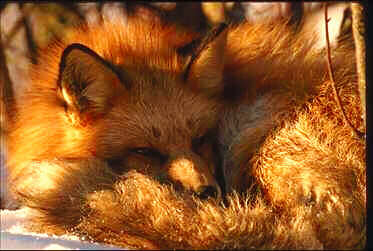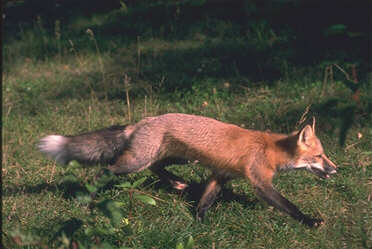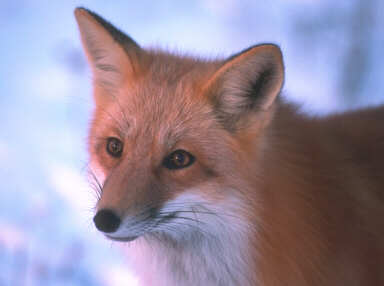
 |
| A red fox in it's winter coat curls up to keep warm. Among other things, it's prominent tail serves as a cozy blanket. |
The largest of all vulpine foxes, the red fox is the most successful, and is certainly the most recognizable. A small, dog like animal, its adult mass can vary between 3-14 kg. European foxes and those living in higher latitudes tend towards the larger sizes, while those in North America and southern latitudes are generally smaller. The males average ten to fifteen percent heavier than the females, although the considerable size differences between individuals in this species makes it difficult to use this as a guideline to determining sex. Body length typically varies between 82 and 110cm, of which a prominent bushy tail accounts for about a third. It is useful as a counterbalance while running and jumping, provides insulation and warmth in cold weather, and is used to communicate with other foxes. A white tail tip, or "tag" is a useful field mark for distinguishing a red fox from other canids. Other characteristic features include its narrow, elongated muzzle, erect triangular ears, and luxurious coat of fur.
The fur consists of a short, very thick undercoat covered with long guard hairs. The typical red fox is light orange to brownish red in colour, with black legs and ears, and a white under belly, chin, and tail tip. Individual coloration tends to be darker in higher latitudes, and winter coats are both darker and thicker. The familiar red pelt is but one of many colour phases of the fox. Cross foxes resemble the typical colour phase but have a prominent black stripe down their back and across the shoulders. The black fox is (naturally) black while the silver fox has a black coat with silver tipped guard hairs giving it a frosted, shimmering appearance. Other less common phases include the Samson fox which has no guard hairs at all, and the bastard fox which is a smoky blue colour between red and black. Some of these phases are common to a particular geographic region. For instance, most black foxes are found near Hudson´s Bay. Despite this, it´s important to realize that these phases are part of one species, and not separate species unto themselves. Various phases can interbreed and offspring of different phases can occur within one litter.
 |
The red fox's lightweight body allows for swift, agile movement. |
The red fox´s feet are typically canine, though somewhat small. Forepaws have five toes and are somewhat wider than the hind paws which have four. One very remarkable feature distinguishing foxes from other canines is their semiretractable claws. This feature helps keep the claws sharp by reducing their contact with the ground. Foxes, like a great deal of other animals, employ digitigrade motion. That is, they walk and run on their toes, with their heals positioned off the ground, high up on the leg. This method of locomotion allows silent, swift, and agile movement, and can also be seen in cats, dogs, and horses. While possessing a basic canine body structure, the red fox is built much more lightly, being half as massive as other canids of equal size. Several of it´s bones are narrower than those of other dogs, and the limb bones are built much more lightly. Body mass is further reduced by a stomach that is proportionately half as large as other canines´. This reduction of weight allows a fox to run extremely quickly (trotting speed is between 6-13 km/h and speeds up to 72 km/h have been cited), and with great agility. Foxes are also very good swimmers and their disproportionately long hind legs give them a tremendous leaping ability of up to 2m vertically.
The fox pays a penalty for it´s smaller stomach in that it must eat more frequently. When eating, it employs 42 teeth within it´s elongated muzzle. These include prominent canines which hold prey, incisors for cutting and shearing meat, and molars for grinding up bones and vegetable matter.
 |
| Distinct sensory features of the red fox include it's erect, triangular ears, long tapered snout, long whiskers and elliptical pupils. |
To catch prey, the red fox has evolved very acute senses. As previously mentioned, foxes and cats have evolved extremely similar eyes. Their retinas are dominated by photoreceptor cells called rods. While rods can not detect colour or produce images as sharp as the cone cells that dominate human eyes, they are much more sensitive and function better in low light. To further improve night vision, nocturnal animals such as foxes and cats developed a reflective layer behind the retina called the tapetum lucidum. It serves to reflect light back onto the retina, thereby doubling the animal´s chance to see something it might otherwise miss. This layer is what makes a cat´s eyes glow in the dark, and has the same effect with foxes. Under conditions of bright light, pupils constrict to protect the delicate photoreceptors. Dogs get by with round pupils, but with their more sensitive eyes, foxes have evolved distinctive elliptical pupils that contract more fully. These features provide excellent ability to detect movement in the dark, although at the cost of clarity and detail particularly under lighter conditions.
Another sensory feature useful in poor light is the fox´s whiskers, or vibrissae. Longer than those of dogs, these cat like whiskers extend from both the snout and the wrists. Tactile information from these vibrissae supplement vision in dim light.
The fox´s triangular shaped ears move continually to improve reception. In "How To Spot A Fox", J. David Henry, describes a "mousing position" in which a fox will elevate its head with it´s ears erect to detect sound. Once prey is detected, the fox will cock or lower it´s head to determine where it is. Foxes possess extremely acute hearing, particularly in the low frequency range. This is very useful in detecting and localizing small animals in under growth or deep snow to within a few centimeters. Hearing is probably the most useful sense to a hunting red fox.
Lastly, foxes have a terrific sense of smell. This is obviously favorable in tracking prey, but is also useful in relocating food caches, and plays a pivotal role in fox communication.
| Table of Contents |